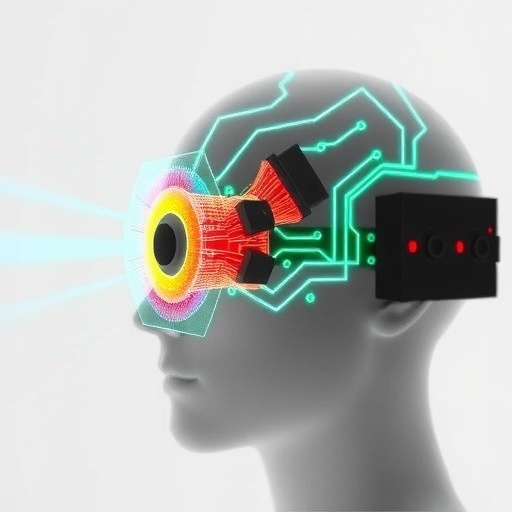In a groundbreaking advancement that could redefine the boundaries of artificial intelligence and human-machine interfaces, researchers have unveiled a multifunctional PN optoelectronic synapse capable of smart integration within an augmented artificial visual system. This pioneering work, led by Lin, Zhu, Hu, and colleagues, reimagines the synaptic functions traditionally observed in biological neural networks, but with the added prowess of optoelectronic versatility. As artificial visual systems strive to emulate human-like perception and learning, the inclusion of such multifunctional synapses marks a significant leap toward achieving truly adaptive and intelligent machines.
At the core of this innovation lies the elegant fusion of photonic and electronic functionalities embodied in a PN junction-based optoelectronic synapse. In contrast to conventional electronic synapses which rely solely on electrical stimuli, this novel device exploits the synergy between light and electrical signals to modulate synaptic weight and memory-like behavior. The PN structure’s inherent bidirectional carrier flow, combined with an optoelectronic response, enables the synapse to mimic complex neuroplasticity mechanisms such as long-term potentiation and depression, essencial for learning processes.
What sets this optoelectronic synapse apart is its ability to seamlessly transition between multiple operational modes depending on environmental inputs and controlled stimuli. Through precise tuning of photoresponse and electrical conductivity, the device demonstrates a remarkable sensitivity and adaptability unprecedented in flexible electronics. This adaptability is not merely a static characteristic but dynamically responds to input signals, allowing the synapse to modulate information in real time much like biological counterparts.
The researchers have meticulously engineered the material composition and structural design of the PN junction to optimize its optoelectronic characteristics. Utilizing state-of-the-art thin-film deposition techniques and nanoscale patterning, they have fabricated devices with ultra-thin active layers that maintain robustness even under mechanical deformation. Such flexibility is crucial for integration in wearable or implantable systems where conformability to curvilinear surfaces is mandatory for consistent performance.
Beyond individual device performance, the study delves into the intelligent integration of these synapses into a larger artificial visual system framework. By interconnecting multiple optoelectronic synapses with light-sensitive arrays, the system achieves real-time image processing capabilities endowed with learning functionalities. This mimics how the human visual cortex processes and adapts to dynamic visual environments, making it highly relevant for applications in robotics, augmented reality, and neuromorphic computing.
The optoelectronic synapse’s ability to encode and retain information optically offers substantial energy savings compared to purely electronic counterparts. This energy-efficient information processing is vital for developing autonomous, self-powered systems where prolonged operation without frequent recharging is essential. Furthermore, this efficiency paves the way toward scalable systems capable of handling vast amounts of sensory data without compromising computational load.
Another fascinating attribute demonstrated in this work is the device’s robustness under diverse ambient conditions. The researchers report stable synaptic responses even under varying light intensities and mechanical strains. Such reliability hints at the technology’s practical viability in real-world applications, where uncontrolled environmental factors often challenge device stability.
Critically, this multifunctional PN synapse embodies true multifunctionality beyond mere synaptic emulation. It operates dually as a sensor and memory unit, capturing environmental cues and modulating synaptic weights accordingly. This confluence embodies a shift from conventional segregated sensing and computation towards an integrated paradigm, bringing artificial systems closer to the adaptive prowess of biological organisms.
The artificial visual system constructed using these synapses showcases augmented vision capabilities, effectively merging sensory input with learning-based enhancement. Unlike static image sensors, this neuromorphic array adapts to fluctuating input patterns, improving recognition accuracy and speed over time. This dynamic adaptability holds promise for perceptual enhancements that can outperform traditional camera systems in complex and variable environments.
Importantly, the study outlines potential architectures for scalable integration, suggesting how these optoelectronic synapses can be arrayed in complex networks without losing synchronization or increasing crosstalk. Their design principles emphasize modularity and compatibility with existing semiconductor fabrication techniques, facilitating quicker transitions from laboratory prototypes to commercial products.
The implications of this research stretch beyond visual systems alone. The basic principles harnessed here could be extended to other sensory modalities and neuromorphic applications, offering a versatile platform for next-generation bioinspired computing. For instance, tactile or auditory sensor networks could incorporate similar synaptic devices to endow machines with finely-tuned sensory processing paired with embedded intelligence.
Moreover, by merging optoelectronic control with neural plasticity, the research sets a foundation for hybrid human-machine interfaces that might one day enable seamless communication between biological nervous systems and artificial devices. This convergence could transform prosthetic technologies, brain-inspired computing architectures, and even cognitive augmentation therapies.
From a materials science perspective, the team’s approach to optimizing charge carrier dynamics and interface engineering between the PN junction layers serves as a model for future optoelectronic devices seeking multifunctionalities. Their efforts underline the necessity of controlling defect states, recombination rates, and carrier lifetimes to harness the full spectrum of light-matter interactions for neuromorphic purposes.
The research also confronts challenges such as device scaling limits, response speed optimization, and long-term endurance under operation-heavy environments. Addressing these issues in future iterations will be critical to transforming this promising prototype into a deployable technology with broad societal impacts.
In conclusion, the multifunctional PN optoelectronic synapse and its integration into an augmented artificial visual system embody a milestone in neuromorphic engineering and flexible electronics. By weaving together optoelectronic responsiveness, synaptic plasticity, and energy-efficient information processing, Lin, Zhu, Hu, and their team have laid out a transformative pathway toward intelligent machines that learn and perceive much like living organisms. This technology is poised to revolutionize artificial vision, robotics, and bioinspired computing domains, heralding an era of devices that do not just sense data but intelligently interpret and adapt to it.
Article References:
Lin, Q., Zhu, Y., Hu, X. et al. Multifunctional PN optoelectronic synapse and its smart integration towards augmented artificial visual system. npj Flex Electron 9, 81 (2025). https://doi.org/10.1038/s41528-025-00459-8
Image Credits: AI Generated




